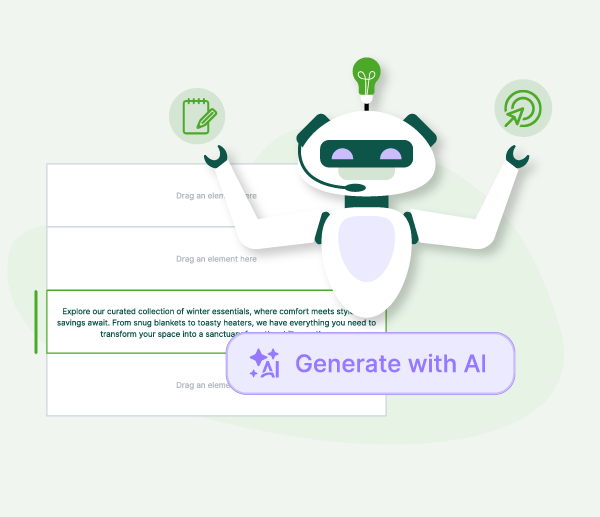Investigation of Personalisation – 6 Steps to Understand the Process
Do you often hear people talk about the importance of personalisation within digital marketing? Well, that’s not very strange. In fact, personalised marketing is rapidly becoming one of the most powerful methods in the digital world. Having said that, it doesn’t necessarily mean that we understand the concept and it’s actual value.
Therefore, we’ll walk you through an investigation of personalisation.
The Explanation of Personalisation
First things first: What is personalisation? Personalisation means that we, as marketers, help our audience to have a richer experience with the help of content or other information that the audience has shown an interest in. Based on this, we can predict what kind of content they might appreciate and interact with in the future.
And as we know – every marketer's dream is to present the best possible message, in the most relevant and attractive way, to the right person, at the right time.

Examples of what type of content and formats you can personalise:
We can’t close our eyes to the fact that in a world of increasing customisation, we can’t skip personalised marketing. Meaning – personalised marketing is part of the trend toward simulating interesting, engaging, and one-to-one interactions with prospects and customers.
Personalise with the Help of Customer Profiles
To get personal, you need to understand your customers – and you need data to understand your customers. An easy way to make this happen, is to create and utilise customer profiles.
By gathering cross-channel data into one source, customer profiles enables you to create a holistic view of your customers. Using the data from your customer profiles makes it possible to gain an in-depth understanding of your customers’ wants and needs.
This, since customer profiles include all interaction data from your customers, gathered via every channel – as soon as it happens. And by knowing your customers for real, you’ll be able to provide them with personalised content. Here’s how it works:
Part 1: Collect Data
The first step in creating customer profiles is to collect data.
Part 2: Collect Data into Profiles
With the help of a Customer Data Platform, the cross-channel data is collected in individual profiles.
Part 3: Turn Data into Action by Segmentation
Once the data is gathered in customer profiles, it’s time to define segments to be able to create personalised messages at scale. This personalisation technique helps you deliver more relevant and personalised marketing to your audience based on, among other things, geographical location, demographics, interests, and purchase history.
Curious about how to become relevant through personalisation? Here you can listen to our podcast episode on the topic!

Is a Strategy for Data and Personalisation Really Necessary?
Yes, it sure is! Actually, it’s key to succeed with your personalised marketing. With this said – before you start with anything else, you need to define your specific business objectives (and goals) and prioritise the information you need before diving into your data.
This means that you need to create a data strategy. The fact that data being one of the most valuable resources within a company, you need to figure out how to use it – before you start working your magic.
Even though we understand the value of information, the unlocking of value can be a true challenge. This because of the high volume of data you have to handle, and the challenges associated with collecting, organising, and activating it.
Developing a data strategy can, therefore, help your company to overcome challenges and access the value of your data while efficiently using your resources.
What Are the Benefits of Personalised Marketing?
We can probably all agree that personalised marketing has rapidly become one of the most powerful marketing methods in the digital world. But – that doesn’t necessarily mean that we understand the real value of it.
So, let’s look at some statistics on how personalised marketing can benefit your business:
- 79% of consumers say they are only likely to engage with an offer if it has been personalised to reflect previous interactions the consumer has with the brand.
- 44% of consumers say that they will likely become returning customers after a personalised shopping experience with a particular company.
- 82% of marketers have reported an increase in open rates through email personalisation.
These statistics show us that personalised marketing creates amazing opportunities to start building strong and powerful relations with our prospects and customers. Evidently, before we even know anything about them…

How to Be Personal Without Being ‘Creepy’ or Clumsy...
...meaning: how are we striking the right balance between personalisation and privacy? And how do we create a personalised experience, without being either over the top or understated?
Which we now certainly can agree on, personalisation is an effective way for you to build strong relationships with your customers. And with strong relationships come increased trust. Meaning: the more trust you leverage – the more data you’ll be entrusted:
- 57% of consumers are willing to exchange data for more personalised offers
- 52% of consumers would share personal data for product recommendations
- 53% of consumers would share data for personalised shopping experiences
Even if customers are willing to share their data, they've also become more conscious of their rights. Therefore it’s your responsibility to respect your customers' right to privacy.
One way to do it, is to ensure that transparency is a priority within your company and that you only use information that the customer has actively given to you. In fact, 28% of people dislike when companies have information about them without the company explicitly asking for permission.
As technology develops, it becomes easier to create a tailored and personalised experience for each individual human. However, this makes the line between joyfulness and taking it one step too far – “freaking out” the customer – a lot fuzzier.

How to Be Respectful
Even if personalisation is key for successful marketing, we must not lose the genuine respect towards our customers. Actually, personalisation going too far – meaning that the consumer feeling or being “watched” – may be enough for consumers to abandon the website or the shopping cart.
This is what you should do to avoid “scaring” your customers:
- Be clear about you collecting data - Use a simple cookie banner at the top or bottom of your webpage that lets visitors know why and how their browsing or purchasing behaviour will be used.
- Know the acceptable limits of data collecting and usage - Keep a close eye on what is currently legal and acceptable among consumers.
- Be selective with the data you use - Having data is great. But be careful with it. For example: A customer can be pleased when seeing their first name in an email, but on the other hand, the person might not want to see his or her name in a website ad.
- Personalise without personal details - This is about considering the specific situation, and it’s worth thinking about the fact that it’s sometimes better to provide a personalised service without being too personal.
Personalisation and the Future
As you can see, personalisation is the current and future wave for the digital business. In fact, by 2020, 51% of consumers will expect that companies will anticipate their needs and make relevant suggestions.

To be able to both stay competitive and become one step ahead of your competitors, it’s about time to turn personalisation into reality. Here’s what you should do:
Use a Customer Data Platform - With the help of a Customer Data Platform (CDP), you can “intervene” in the customer journey. A CDP enables personalisation based on behavioural data – meaning you can identify and segment your customers based on their interests and behaviours. After that, the CDP help you target (or not target them) your customers based on what stage of the customer journey they are.
Our platform APSIS One, that combines the power of a CDP with efficient digital marketing tools, contains all you need to create a personalised and consistent brand experience – regardless of channel or device. Thus, by using APSIS One you’ll be able to create a single customer view and gain a better understanding of your customers.
Also, you'll gain insights on how to create better personalisation in the future. And – with the help of marketing automation – deliver personalised messages to the right person, with perfect timing.
Be agile with cross-functional teams - Personalisation requires agile management including cross-functional teams with the ability to adapt quickly and execute rapidly.
One of the biggest threats against the ability to create a seamless and personalised customer experience is having different departments working in different ways – believing that they are working towards the same goal. Therefore, your organisation needs to be agile with cross-department collaboration.
Get started - preferably right now!
Interested in how you can take your personalisation skills to the next level? Contact one of our digital experts, and they’ll show you how it works!



